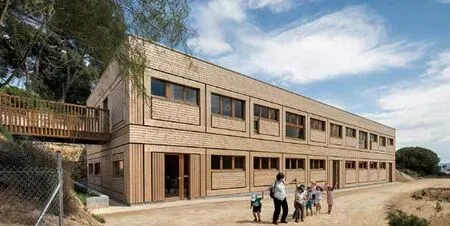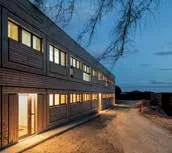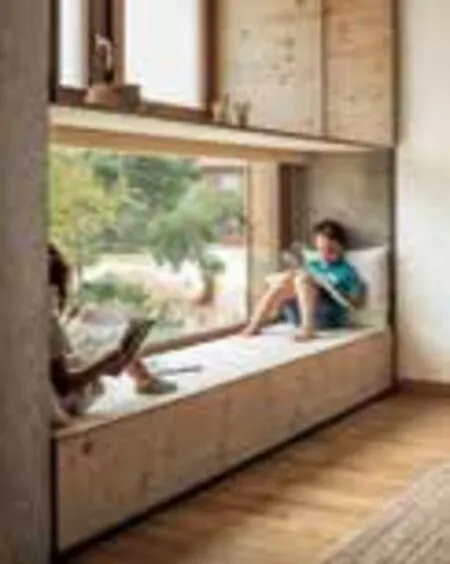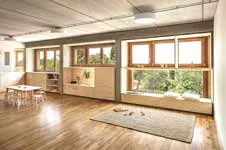巴塞罗那华尔道夫学校
设计:SEduard Balcells、IgnasiRius、Daniel Tigges
摄影:Adrià Goula
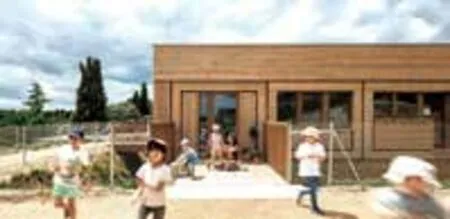
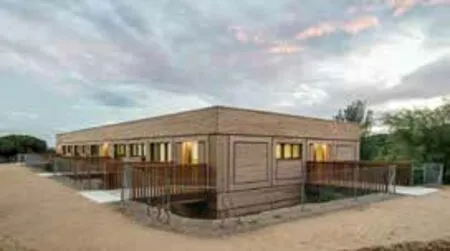
改建5 座建筑与1 座花园:El Til·ler -Linden Tree-学校位于西班牙Bellaterra 郊区的一片废弃大型私人花园之中,毗邻巴塞罗那。整个建筑群沿着现有主路排布,道路现在是商业街,其一侧是面向景观开放的广场。6座建筑中的5 座由现有的模块化体量木材与钢材建造,材料来源于2 座学校的原有建筑。这些建筑运来新场地进行重新组装,以适应新地形、植被、光线和周边环境。现有的第六座建筑是幼儿园和公共空间。
序列、横向空间、光影关系。城市设计是教育另一种表达方式:这座学校有着Waldorf-Steiner 当代教育空间特征表达方式,能够很好地适应地中海气候。建筑中没有走廊,学生们进入教室会首先通过外部空间序列:即核心区、院落、门廊、接待大厅,再到达教室。随着年级的升高,教室体量的视线也逐渐变得开阔,教室随着地形的变化带来了不同强度、色彩的光线效果。每间教室都有着序列、横向空间、光影关系之间的独特特征,伴随着孩子们一路成长。
壁龛与框架。建筑在这里也代表着教学方式:新建筑包含有幼儿园与公共空间,建筑师将平面从柱列中释放出来,并将它们集中于厚重墙体形态的立面之中,幼儿园教室便位于多功能无柱空间之上。扶壁之间的空间成为了壁龛,能够根据不同教学空间的需求进行改造。外部,壁龛包含在框架之中,这些框架使立面井然有序,并从视觉上缩小建筑,给孩子们亲切的尺度感。
全木材立面:立面由全木材和半预制性的混凝土结构形成。紧凑轻捷的建筑体量由内部三层松木面板支撑并配有保温的木纤维面板。外表采用固定在通风室上的保温松木板条。这种木纤维面板得以优化预算。
被动式气候舒适性。没有暖气的学校:原位柱和周边梁组成的大体积混凝土结构和预制混凝土面板带来充足的热惰性,既吸收了教室高度产生的热量,同时防止夏季过热。
因此,没有热桥的保温材料加上大型热惰性混凝土结构几乎避免了冬季供暖的需求,最寒冷的时候教室里也只需要一个小的电散热器。通风立面、外部铝制百叶、自然交叉通风保证了除冬季外的热舒适性。
建筑立面由普通的形态转变成充满生气的空间,教室成为了一个一个小房间,整座学校也构成了沿街的一座小村落。
Recycling five buildings and a garden:The El Til•ler -Linden Tree-School is carefully inserted into a large,mature and abandoned private gardenclose to Barcelona.The complex is articulated along the existing main access path,which becomes a“rambla”-the Mediterranean name for high street-that ends at a square which opens to the landscape.Five of the six buildings which make up the school are existing modular pavilions of wood and steel which come from two other sites previously occupied by the school.These buildings are disassembled,transported and precisely reconfigured at the new site,adapting to the topography,existing vegetation,sun exposure and views.The sixth building,which is presented here,houses the kindergarten and the common spaces.
Sequences,horizons,light.Urban design as an expression of pedagogy:The school proposes a contemporary spatial expression of the Waldorf-Steiner pedagogy adapted to a Mediterranean climate.Thus,there are no interior corridors,and access to the classroom follows a gradual exterior spatial sequence:rambla–courtyard–porch -receiving hall -classroom.The horizons -the views-expand as the child grows,and the rotation of the classrooms on the topography gives them varying light qualities,both in intensity and color.Sequences,horizons and light personalize each classroom,emphasizing and accompanying the experience of growing up and learning.
Alcoves and frames.Architectureas an expression of pedagogy:The new building,which houses the kindergarten and common spaces,frees the plan from columns and concentrates them at the facades in the shape of thick buttresses,making it possible to place the kindergarten classrooms on top of a necessarily column-free multi-purpose hall.The spaces between the buttresses become alcoves,which are shaped according to the functional and pedagogical needs of each space.On the outside,the alcoves are contained within frames which order the facade and visually reduce the size of the building,bringing it closer to that of children.
All-wood facades:The facades are entirely made of wood and are formed by large format prefabricated elements.The“balloon frame”elementshave a threelayered pine panel finishing inside,and thermal insulation of wood-fibre panels.The covering is made of thermally-modified pine wood slats,which are fixed on a ventilated chamber.This so called thermowood will no longer require any subsequent maintenance.
Passive climatic comfort.A school without heating:The massive concrete structure,consisting of in situ columns and perimetral beams,with prefabricated concrete plates,provides a large thermal inertia,storing the heat generated by the high occupation of the classrooms and,at the same time,preventing excessive heating in summer.
Thus,the combination of the thermal insulation without thermal bridges,together with the large thermal inertia of the concrete structure,almost eliminate the need for heating in winter,where only a small electric radiator is used for each classroom in moments of cold peaks.Comfort during the rest of the year is achieved through cross ventilation,ventilated facades and external Venetian blinds.
The facade evolves from a flat surface into an inhabited space,the classroom turns into a house and the school becomes a small village along a rambla.
